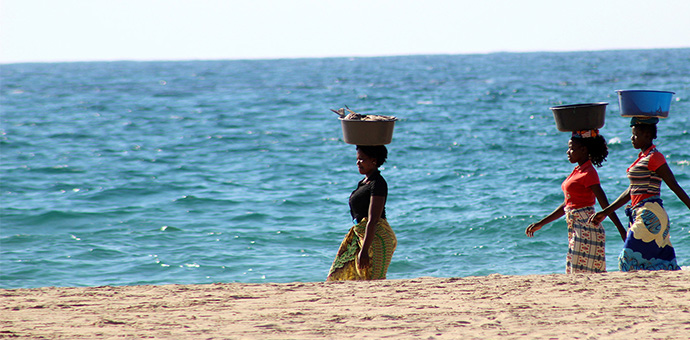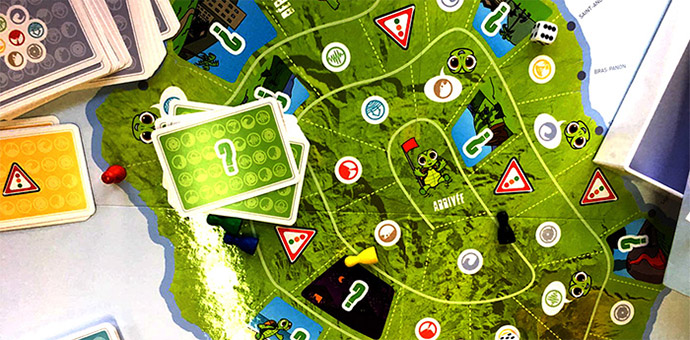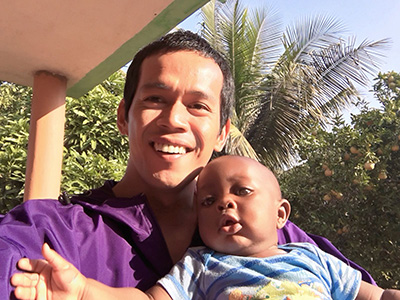RC/RCCC Notes from the Field: Climate Message and Land of Good Peopleby Juhri Selamet |
|
A group of women walking back from the local market on Barra Beach, Mozambique. Photo: Juhri Selamet. |
|
Arielle, Delegada da Pesquiça (Research Delegate of Forecast-based Financing) told me there was an exciting event held at Centro Cultural Franco-Moçambicano, Maputo, and she asked whether or not I was interested in joining the event, which, of course, I was. The Centro Cultural Franco was only about a 15 minute drive from Cruz Vermelha De Moçambique. It was a Climate Changes games event hosted by France Red Cross. When I arrived at the Center around 9 a.m., Janio Danio Dambo, Gestor da CVM do Projecto FbP (Forecast-based Financing project manager of Mozambique Red Cross), was already there to join and facilitate the event. The participants for the event were from several institutions, such as NGOs and governmental institutions. From the participants' introductions, I learned that some of them were from Instituto Nacional de Gestão de Calamides (INGC) (National Disasters Management Institute), Instituto Nacional de Meteorologia de Moçambique (INAM) (National Meteorology Institute), Direcção Nacional de Águas (DNGRH) (National Water Directorate), and Red Cross. From my observation, there were 13 female participants and 16 male participants for this event. After gathering in the center's lobby for a short explanation about the activity, we moved to the second floor to partake in the workshop. By 10 a.m., we started to play the game called "Climate Message." We were divided into two groups. Eric SAM-VAH, Adjoint au chef de delegation, Gestion des risques de catastrophes – Deputy Head of Delegation, Disaster Risk Management from France Red Cross had prepared a climate message on a piece of paper to be shared with the groups. The climate message was in three languages: French, Portuguese, and English. In English, I noted the message was: "Currently we are experiencing a strong ENSO signal, and are in an El Nino phase. There is a 60% chance that there will be less than average rainfall and a 45% chance that the maximum temperatures will be lower than average for the months of November, December, and January. The long-term forecasts show that there is an increased chance that the central parts of the country might experience drier conditions or even drought conditions." As we sat in a line, Eric explained the setting that different extension officers had been tasked to share the seasonal climate forecast with the farmers of their area. They hold a meeting with lead farmers and pass on the seasonal forecast message. The rules of the game were no repeating of the message – only say it once – and no notes may be taken. I was the first person in the row, so Eric handed the letter to me to be told the forecast. I turned to my group, laughed, "Inglês ou Portugues?" They said they wanted the message in Portuguese. Since I did not want to make the group feel lost with my broken 'Portuguese' pronunciation while reading the message, I gave the message to the person who sat next to me, telling him, "I cannot handle this big responsibility." The message was passed one-by-one to each of the participants. They made shocked faces when they heard the message. Janio kept reminding the groups that there would be no repeating of the message, "Only say it once," he said. Once the message reached the end of the line, Eric asked the last person of the groups to write down the message that had reached them; he asked them to read it as well. After that, Eric asked the first person who received the message to read the original message. One of the questions that I remember Eric asking the groups was, "What made it easy or difficult to communicate a climate message?" which, from my note, the groups responded the message was too long and too "complicado." |
|
A game designed to teach children and communities about climate change. (credit: Juhri Selamet). |
|
At the end of the climate message game, Eric, as facilitator, explained to us the game's relevance to climate resilience and that complex climate messages could often cause more confusion than clarity. This light-hearted exercise could open the space for an exploration of the effectiveness of seasonal forecasts and how to communicate them effectively without oversimplifying the message. The objectives of this activity were learning to explore how complex climate messages are transferred and to explore options for appropriate use of climate messages. From this activity, as players for the games, we have learned the challenges associated with climate communication. It encourages us to take action and develop solutions to provide knowledge and understanding of the climate issue that could be adapted to local context. There were many laughs and much discussion, and for sure, we had fun at that event. I was fortunate to attend and participate in this activity. ‘Land of Good People’In my sixth week in Maputo, as we had a public holiday on Monday, June 25th, 2018, I spent a three-day weekend outside Maputo and saw other provinces in Mozambique. I discussed this plan to Samuel Massango, Gestor da CVM dos PAAs/EAPs, CVM Manager of the PAAs/EAPs for the FbF project, and he offered a help take me to Inhambane. So, on Saturday morning, we drove about 9 hours from Maputo city to Inhambane province, a province of Mozambique located on the coast in the southern part of the country. |
|
On our way to Inhambane, we crossed the Gaza province. When we were making a stop in Xai-xai, the capital of the province of Gaza, Samuel gave me a brief explanation of the FbF project in three districts in Gaza. Those districts are Chokwe, Guijá, and Chibuto. The choice of districts was based on the historical impact and magnitude of extreme events, and these three districts have had a high number of deaths resulting from floods. As we arrived in Inhambane, we stopped at the Red Cross office of Inhambane province for a while before driving to Barra. Barra lies on the Indian Ocean coast, on the Ponta da Barra peninsula in Inhambane Province, which is about a 25 km drive from Inhambane city. "Where are you from, originally?" asked Andre, warmly, when we first arrived in Barra. When I told him that I am Indonesian, he replied, "Wow. A long way from home, huh! Hope you will have a great time here!" I did have a good time in Barra. |
Juhri Selamet, Red Cross Red Crescent Climate Centre Junior Researcher, with baby Eliseu. |
At the beginning, I told Samuel that I might fall asleep on the way back to Maputo. However, the Mozambique countryside amazed me with handsome landscapes and colorful street markets. We stopped many times to buy many things, ranging from cordwood to papayas. We dropped cordwood and oranges that we had bought on the street at Samuel’s family's place while stopping there. Samuel's mother-in-law served us a delicious lunch and allowed me to play with a cute baby named Eliseu. It is true. Inhambane, also known as Terra de Boa Gente, translates to the "Land of Good People." Juhri Selamet, juhri.selamet@colorado.eduCMCI PhD student, 2018 CU-RCRCCC Intern |
|



 Juhri Selamet is the 2018 Junior Researcher in the
Juhri Selamet is the 2018 Junior Researcher in the 
